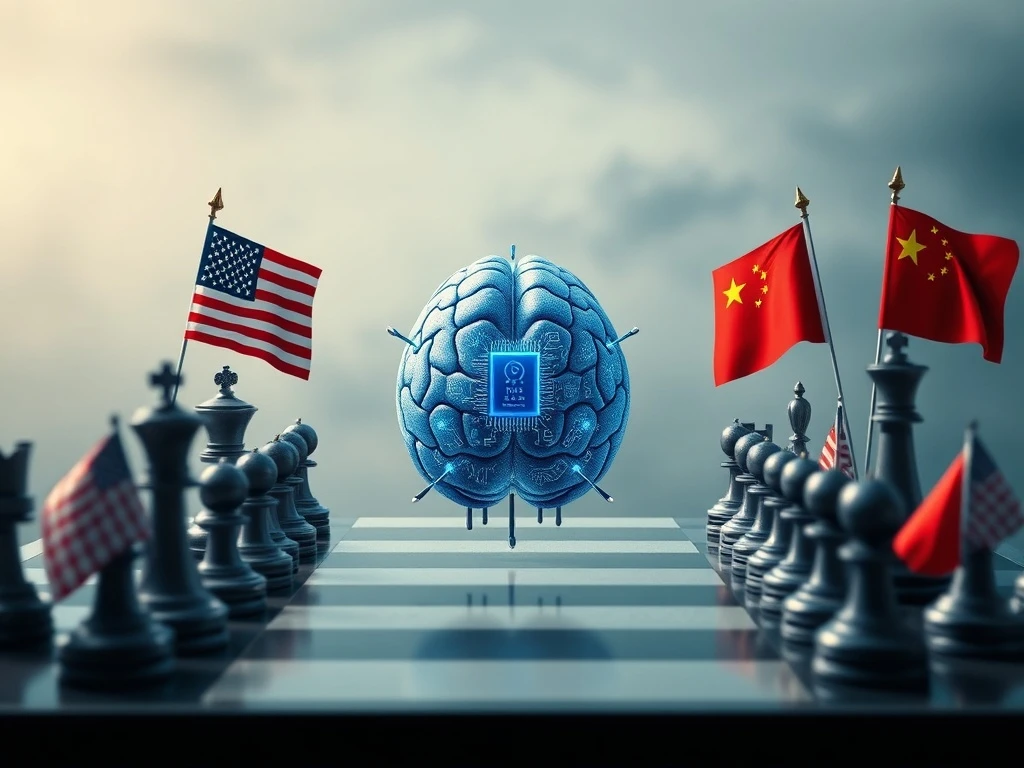Trump’s Bold AI Plan: Crucial Chip Export Controls Escalate US-China Tech War

In an era where technological supremacy dictates global power, the latest Trump AI Plan has sent ripples across industries, from advanced computing to the volatile cryptocurrency markets. This ambitious strategy aims to significantly tighten chip export controls, directly targeting China’s rapid technological ascent. For those invested in digital assets, understanding these geopolitical maneuvers is crucial, as shifts in the global semiconductor supply chain can directly influence market stability and innovation pipelines.
Unpacking the Trump AI Plan: A Strategic Pivot in the US China Tech War
The Trump administration’s recently unveiled AI Action Plan marks a pivotal moment in the ongoing US China tech war. At its core, the plan is a strategic pivot designed to solidify American leadership in artificial intelligence while simultaneously addressing national security concerns. A key focus is preventing adversaries from leveraging cutting-edge AI innovations, particularly those with dual-use capabilities—meaning they can serve both commercial and military purposes. The plan’s broad goals emphasize maintaining America’s technological edge, but critics note that the practical implementation details remain somewhat vague, raising questions about its immediate effectiveness.
This initiative isn’t just about general AI; it’s a laser focus on the critical hardware that powers it: advanced AI chips. These semiconductors are the bedrock of modern AI, enabling everything from sophisticated algorithms to complex data processing. By reinforcing export controls on these vital components, the U.S. aims to create a technological bottleneck for nations deemed a threat. The plan highlights:
- Maintaining American Leadership: Ensuring the U.S. remains at the forefront of AI development and application.
- Addressing Dual-Use Technologies: Preventing AI tools and components from being repurposed for military or adversarial uses.
- Strategic Export Control Reinforcement: Placing stricter limitations on the sale of advanced semiconductors to specific countries.
The Battle for Advanced AI Chips: Why It Matters
Central to the new strategy is a deep dive into how advanced AI chips are manufactured and distributed globally. The administration is pushing for innovative solutions like “chip location verification” and expanding restrictions to “component sub-systems.” This indicates a nuanced understanding of the intricate global semiconductor supply chain. Imagine a single AI chip; its design might originate in the U.S., be fabricated in Taiwan, and then assembled in Malaysia. Each step involves multiple countries and suppliers, creating a complex web of dependencies.
The concept of “chip location verification” aims to ensure that exported chips are not diverted to unauthorized users, addressing a significant vulnerability. Furthermore, extending export restrictions to sub-systems—smaller, yet vital parts of chip manufacturing that are currently less regulated—demonstrates an effort to close potential loopholes. This proactive approach reflects the administration’s recognition that controlling the finished product alone might not be enough to curb technological proliferation.
Navigating the Semiconductor Supply Chain Labyrinth
The global semiconductor supply chain is a marvel of modern engineering, yet also a profound vulnerability in the context of the US China tech war. Designing a chip, fabricating it, and then assembling it often spans multiple continents, making comprehensive control incredibly challenging. The Trump AI Plan emphasizes targeting supply chain choke points—those critical junctures where disruption can have maximum impact. However, this requires unprecedented coordination across nations and private companies, a feat that remains largely unproven.
Moreover, the inherent dual-use nature of advanced AI chips complicates enforcement. How do you distinguish between a chip destined for a commercial data center and one intended for military AI applications? This ambiguity poses a significant regulatory hurdle. Past policy inconsistencies further compound the issue. For instance, recent reversals, such as sudden approvals for Nvidia and AMD to sell AI chips to China after prior restrictions, illustrate the volatile regulatory landscape. Such shifts create immense uncertainty for businesses, impacting investment decisions and long-term planning, and raising questions about policy continuity and strategic clarity.
Global Alignment and the Future of Chip Export Controls
A critical element of the Trump AI Plan‘s success hinges on securing global alignment with allies. The administration has signaled potential economic penalties, including secondary tariffs, for nations that do not adopt U.S. chip export controls standards. The Foreign Direct Product Rule (FDPR), a powerful tool allowing the U.S. to restrict foreign-produced goods reliant on American technology, is positioned as a key lever for enforcing compliance.
However, achieving consensus among allies is a significant hurdle. Conflicting economic interests and geopolitical priorities often complicate coordinated action. While diplomatic persuasion is a cornerstone of the plan, the administration recognizes that unilateral measures may be circumvented without international buy-in. The plan, at this stage, serves more as a foundational framework, with concrete actions likely to be phased in. Upcoming executive orders are expected to prioritize convening stakeholders rather than imposing immediate, sweeping restrictions, acknowledging the technical and diplomatic intricacies involved.
Economic Fallout: Impact on Industries and Cryptocurrencies
The economic implications of these intensified chip export controls could be far-reaching. U.S. semiconductor companies may face significant revenue losses from restricted access to lucrative Chinese markets, even as they potentially benefit from domestic investment incentives aimed at bolstering American manufacturing. Meanwhile, increased global trade friction could fragment the tech ecosystem, slowing innovation as companies adapt to disparate regulations and navigate a more complex global semiconductor supply chain.
For sectors like cryptocurrencies, such geopolitical tensions and supply chain disruptions can introduce considerable market volatility. Investor confidence can be shaken, potentially affecting token prices and overall market sentiment. Furthermore, the development of blockchain infrastructure, which often relies on high-performance computing and specialized chips (e.g., for mining or complex smart contract execution), could face indirect impacts from restricted access to certain technologies or increased costs. The delicate balance between national security and fostering innovation will determine the ultimate economic footprint of this ambitious plan.
Conclusion: Navigating a Complex Future
The Trump AI Plan, with its focus on strengthening chip export controls, is a clear signal of the U.S.’s determination to maintain its technological lead in the US China tech war. While the plan sets ambitious goals for controlling the flow of advanced AI chips and securing the semiconductor supply chain, its success hinges on overcoming significant challenges—from achieving global consensus among allies to navigating the inherent complexities of dual-use technologies and past policy inconsistencies. The path ahead is fraught with diplomatic tensions and enforcement difficulties, but also presents opportunities for bolstering domestic semiconductor resilience and fostering new international collaborations. Its ultimate impact on global technology, trade, and even the stability of cryptocurrency markets will depend on its ability to translate broad objectives into actionable, sustainable policies that can adapt to a rapidly evolving globalized tech landscape.
Frequently Asked Questions (FAQs)
What is the primary goal of the Trump AI Plan regarding chip exports?
The primary goal of the Trump AI Plan is to strengthen control over advanced artificial intelligence technologies, specifically by tightening export controls on sophisticated AI chips to China, aiming to maintain American leadership in AI and address national security concerns related to dual-use technologies.
How do these new chip export controls affect the semiconductor supply chain?
These controls aim to address vulnerabilities in the global semiconductor supply chain by focusing on “chip location verification” and expanding restrictions to “component sub-systems.” This seeks to prevent diversion of chips to unauthorized users and regulate smaller, vital parts of chip manufacturing, which can complicate the intricate global production process.
What role does the Foreign Direct Product Rule (FDPR) play in this strategy?
The Foreign Direct Product Rule (FDPR) is positioned as a key lever to enforce compliance. It allows the U.S. to restrict foreign-produced goods that rely on American technology or software, aiming to pressure allies to adopt U.S. export control standards and ensure global alignment.
What are the challenges in implementing these advanced AI chip export controls?
Challenges include achieving global alignment among allies due to conflicting economic interests, the dual-use nature of advanced AI chips (making it hard to distinguish legitimate from illicit use), the complex globalized supply chain, and past policy inconsistencies that create uncertainty for businesses.
How might these policies impact the cryptocurrency market?
Increased geopolitical tensions and supply chain disruptions resulting from these policies could introduce market volatility for cryptocurrencies. Investor confidence might be affected, and the development of blockchain infrastructure, which relies on high-performance computing, could face indirect impacts from restricted technology access or increased costs.
Has there been any history of policy inconsistencies regarding chip exports?
Yes, the article mentions past policy inconsistencies, such as sudden approvals for Nvidia and AMD to sell AI chips to China after prior restrictions, and the rescission of the Biden-era AI Diffusion Rule, which create uncertainty and raise questions about policy continuity.









